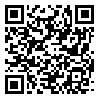Volume 10, Issue 4 (winter 2007)
2007, 10(4): 147-160 |
Back to browse issues page
Download citation:
BibTeX | RIS | EndNote | Medlars | ProCite | Reference Manager | RefWorks
Send citation to:



BibTeX | RIS | EndNote | Medlars | ProCite | Reference Manager | RefWorks
Send citation to:
A. Sarkhosh, Z. Zamani, M. R. Fatahi Moghaddam, A. Ebadi, A. Saie, S. Z. Tabatabaie et al . Study on Relationships among Fruit Quantitative and Qualitative Characteristics of Some Pomegranate Genotypes. Journal of Crop Production and Processing 2007; 10 (4) :147-160
URL: http://jcpp.iut.ac.ir/article-1-612-en.html
URL: http://jcpp.iut.ac.ir/article-1-612-en.html
A. Sarkhosh * 
 , Z. Zamani
, Z. Zamani 
 , M. R. Fatahi Moghaddam
, M. R. Fatahi Moghaddam 
 , A. Ebadi
, A. Ebadi 
 , A. Saie
, A. Saie 
 , S. Z. Tabatabaie
, S. Z. Tabatabaie 
 , M. R. Akrami
, M. R. Akrami 


 , Z. Zamani
, Z. Zamani 
 , M. R. Fatahi Moghaddam
, M. R. Fatahi Moghaddam 
 , A. Ebadi
, A. Ebadi 
 , A. Saie
, A. Saie 
 , S. Z. Tabatabaie
, S. Z. Tabatabaie 
 , M. R. Akrami
, M. R. Akrami 

Abstract: (21888 Views)
In order to determine the most important quantitative and qualitative characteristics of pomegranate fruit and its components for categorizing the genotypes, a study was carried out using 24 genotypes. In this study 28 quantitative and qualitative characteristics of pomegranate fruit and seed were evaluated. Analysis of variance showed that all of the characteristics in examined genotypes were significant, showing high variability in characteristics. Results of simple correlation analysis showed the existence of significant, positive and negative correlations among some important characteristics. Also, factor analysis showed that most of fruit juice, aril and seed characteristics constituted the main factors. Effective characteristics categorized in seven factors accounted for 89% of total variance. For each factor, eigen value more than 0.7 was considered significant. Cluster analysis was performed using these seven factors and genotypes, in the distance of 9, were divided into 5 main clusters. These groups were mainly distinct in fruit flavor and soft seededness. Furthermore, by using three main factors, genotypes positions determined in 3-plot analysis, which distinguished sweeter genotypes from sweet-sour and sour genotypes.
Keywords: Pomegranate, Quantitative and qualitative characteristics, Cluster analysis, Multivariate analysis, Factor analysis.
| Rights and permissions | |
 | This work is licensed under a Creative Commons Attribution-NonCommercial 4.0 International License. |




